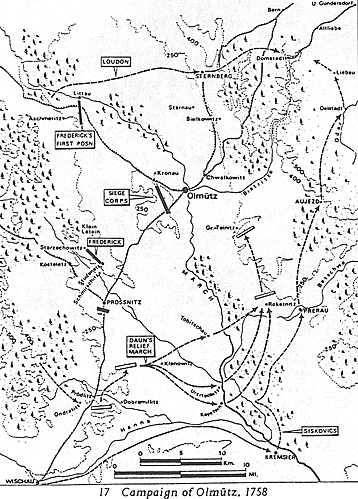
The fourth convoy had been collected by transport chief, Lt. Colonel Mosel. Apart from two garrison battalions drawn from Brieg and Breslau, all of the 9,200 strong escort were either recruits or reconvalescents in units reconstituted after the heavy fighting of the previous Autumn. There were probably over 4,000 civilian baggage attendents and 16,000 transport horse making up this huge column.
17 Campaign of Olmutz, 1758 The map of the Olmutz campaign is provided courtesy of Christopher Duffy from The Military Life of Frederick the Great.
Having passed through Troppau safely, Mosel arrived in the small town of Bautsch at midday June 26th. From here on, the route ran along tolerable roads across undulating countryside surrounded by spruce woods, through Unter-Gundersdorf and Altliebe, to the impoverished town of Domstadtl. A further 13 miles of wooded, hilly country lay between Domstadtl and Olmutz. The nearest Prussian troops were Zieten's detachment on the Bistritza River, near Olmutz [4].
Following reports of enemy troops converging on this route, Keith instructed Zieten to make contact with the convoy. Zieten despatched Colonel Warner with approximately 1,000 men to the village of Giebau, between him and Domstadtl. Mosel, also hearing of the threat, drew the convoy into a defensive wagonberg at Bautsch. As no attack came, he set out at 2 a.m. June 28, hoping to reach Domstadtl by midnight. As the advance guard cleared UnterGundersdorf, two hours later, shots rang out from three batteries north of the road; the attack had begun.
Austrian Preparations
The Austrians had been preparing the trap since the convoy had left Troppau as part of a larger plan to relieve Olmutz. The main Austrian army of 45,000 men under Field Marshal Daun had moved in a wide arc from its positions in wooded hills 25 miles west of Olmutz to Dobramillitz, opposite Frederick's troops south of the city. Generals Siskovics andSt Ignon moved to Prerau southeast of Olmutz with another 4,000 men, while Buccow and a force of 12,000 troops advanced on Littau to the northeast. General DeVille screened the main army with 5,000 Austrian and Saxon cavlary close to the Prussian positions at Prossnitz. Meanwhile, General Bieberstein clung on to Olmutz with 10,000 Austrian and Bavarian infantry.
Covered by fients against Prussian outposts, the Austrians now began a series of moves designed to tighten the noose around Frederick's and Keith's armies and cut them off from the vital convoy. First, 1,200 reinforcements were pushed through the weak Prussian forces east of Olmutz to bolster the garrison (June 21st); then, Siskovics and St Ignon moved northwards from Prerau to attack the convoy from the east, while Buccow sent Major General Baron Loudon with 4,100 men to Sternberg to attack from the west. Having deceived Frederick by a fient towards his positions at Prossnitz, Daun nimbly doubled back southeastwards, crossed the March River and arrived on the heights at Gross Teinitz on July 1, only one hour from Olmutz. However, by then, the fate of the Prussian operations had already been determined by the actions of Loudon and Siskovics.
The Ambush of the Olmutz Convoy At Domstadtl June 28-30, 1758
- Introduction
The Olmutz Convoy
Rounds 1 and 2
Commentary, Footnotes, Bibliography
Orders of Battle: Prussian and Austrian
Jumbo Campaign Map (very slow: 237K)
Large Convoy Map (slow: 76K)
Back to Seven Years War Asso. Journal Vol. VIII No. 4 Table of Contents
Back to Seven Years War Asso. Journal List of Issues
Back to Master Magazine List
© Copyright 1996 by James E. Purky
This article appears in MagWeb.com (Magazine Web) on the Internet World Wide Web.
Other articles from military history and related magazines are available at http://www.magweb.com